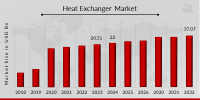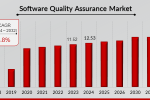(EMAILWIRE.COM, June 30, 2025 ) Heat Exchanger Market Overview
According to a Comprehensive Research Study by Market Research Future (MRFR), Heat Exchanger Market Information By Type and Application – Forecast till 2032. The Heat Exchanger Market industry is projected to grow from USD 22 Billion in 2024 to USD 37.07 Billion by 2032, exhibiting a compound annual growth rate (CAGR) of 6.06% during the forecast period (2024 – 2032). Heat Exchanger Market Size was valued at USD 20.51 Billion in 2023.
The increasing consumption of energy and the emphasis on optimizing energy usage in industrial applications are fueling the demand for advanced heat exchange solutions. In particular, the HVAC and power generation industries are major contributors to the markets expansion, with renewable energy technologies and the push toward net-zero emissions further supporting its growth.
Request To Free Sample of Report:
rnhttps://www.marketresearchfuture.com/sample_request/2963
Key Companies:
Alfa Laval AB (Sweden)
Kelvion Holdings Gmbh (Germany)
Southern Heat Exchanger (U.S.)
Danfoss A/S (Denmark)
SPX Corporation (U.S.)
Xylem Inc. (U.S.)
API Heat Transfer Inc. (U.S)
Gunter AG & Co. KG (Germany)
Sierra S.p.A (Italy)
Hamon & Cie International SA (Belgium)
Koch Heat Transfer Company (U.S.)
Hughes Anderson Heat Exchangers (U.S.)
Market Dynamics and Growth Drivers
The heat exchanger market is influenced by a combination of macroeconomic, technological, and regulatory factors. One of the strongest dynamics is the rise in industrialization and urbanization, particularly in developing regions such as Asia-Pacific and Latin America. This surge is increasing the demand for thermal systems in construction, manufacturing, and energy production.
Furthermore, the shift toward decarbonization and sustainable manufacturing practices is compelling industries to upgrade their thermal systems. Heat exchangers play a key role in improving energy efficiency, reducing operational costs, and minimizing environmental impact, thereby becoming integral to green transitions.
Key Market Drivers
Several primary drivers are fueling the growth of the heat exchanger market:
Energy Efficiency and Sustainability: Heat exchangers contribute significantly to energy savings by recovering and reusing waste heat in industrial processes. As energy prices fluctuate and sustainability goals become stricter, businesses are increasingly adopting energy-efficient equipment, with heat exchangers being at the forefront.
Growth in HVAC and Refrigeration Applications: The expansion of commercial and residential infrastructure globally is resulting in high demand for HVAC systems. Heat exchangers are central to cooling and heating applications, making this sector a key growth area.
Industrial Process Demand: Chemical processing, oil refining, and power plants require robust and reliable thermal systems. The increasing scale and complexity of such operations necessitate high-performance heat exchangers that can withstand extreme temperatures and pressures.
Renewable Energy Expansion: Heat exchangers are also essential in renewable energy systems such as geothermal and solar thermal applications. The increasing adoption of clean energy further boosts demand for these devices.
Heat Exchanger Market Segmentation
Heat Exchanger Maintenance Type Outlook
Shell & Tube
Plate
Regenerative
Air-cooled
Heat Exchanger Application Outlook
Chemicals
Oil & Gas
Power Generation
HVACR
Food & Beverages
Other
Heat Exchanger Regional Outlook
North America
US
Canada
Europe
Germany
France
UK
Italy
Spain
Rest of Europe
Asia-Pacific
China
Japan
India
Australia
South Korea
Australia
Rest of Asia-Pacific
Rest of the World
Middle East
Africa
Latin America
Purchase Complete Report:
rnhttps://www.marketresearchfuture.com/checkout?currency=one_user-USD&report_id=2963
Technological Advancements and Innovation
Technological innovation is a cornerstone of market evolution. Modern heat exchangers are increasingly incorporating advanced materials like stainless steel alloys, titanium, and even composite materials to enhance thermal conductivity, corrosion resistance, and mechanical strength.
Recent innovations also include the development of compact and micro heat exchangers, which are highly efficient in small-scale applications, including electronics cooling and microreactors. Additionally, additive manufacturing (3D printing) is being explored for custom and complex heat exchanger geometries that were previously difficult to manufacture using traditional techniques.
Challenges and Market Constraints
Despite the markets robust potential, several challenges persist:
High Initial Costs: Advanced heat exchanger systems, particularly those using specialized materials or custom configurations, can be expensive. Small and medium enterprises may face financial barriers to adoption.
Fouling and Corrosion Issues: Over time, heat exchangers can suffer from fouling due to scale, sludge, or biological growth, which reduces efficiency. Regular maintenance is necessary, increasing operational costs and downtime.
Complex Design Requirements: Tailoring a heat exchanger to specific process conditions often requires detailed engineering and customization, which can delay implementation and increase costs.
Regulatory Hurdles: Complying with environmental and safety regulations across multiple jurisdictions can be challenging, especially for global manufacturers.
Browse In-depth Market Research Report:
rnhttps://www.marketresearchfuture.com/reports/heat-exchanger-market-2963
Outlook and Future Trends
Looking ahead, the heat exchanger market is poised for significant transformation driven by digitalization, environmental policy, and technological breakthroughs. The Asia-Pacific region, led by China and India, is expected to dominate market growth due to rising energy needs, industrial expansion, and government incentives for energy-efficient technologies.
In Europe, the emphasis on reducing greenhouse gas emissions and achieving energy efficiency in manufacturing will continue to fuel demand for sophisticated heat exchanger systems. Similarly, the U.S. market is likely to grow due to infrastructure development and aging thermal systems in power and chemical plants that require modernization.
The integration of artificial intelligence and data analytics is set to revolutionize the way heat exchangers are monitored and managed. These tools will allow for better diagnostics, optimization, and predictive maintenance, enhancing overall system performance.
Another trend to watch is the increased focus on modular and prefabricated systems, particularly in remote or temporary industrial setups such as mining or construction camps. These units can be deployed rapidly and tailored to specific applications.
Related Reports:
Utility Scale Green Power Transformer Market: https://www.marketresearchfuture.com/reports/utility-scale-green-power-transformer-market-29334
Subsea Equipment Market: https://www.marketresearchfuture.com/reports/subsea-equipment-market-28876
Oil & Gas Engineering Services Market: https://www.marketresearchfuture.com/reports/oil-gas-engineering-services-market-11776
Biorefinery Market: https://www.marketresearchfuture.com/reports/biorefinery-market-11289







